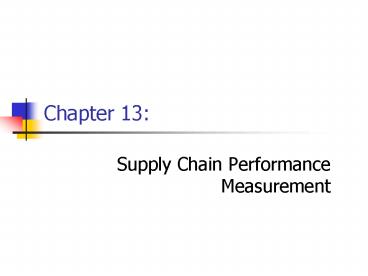Supply Chain Performance Measurement - PowerPoint PPT Presentation
1 / 27
Title:
Supply Chain Performance Measurement
Description:
Chapter 13: Supply Chain Performance Measurement Learning Objectives - After reading this chapter, you should be able to do the following: Understand the scope and ... – PowerPoint PPT presentation
Number of Views:1209
Avg rating:3.0/5.0
Title: Supply Chain Performance Measurement
1
Chapter 13
- Supply Chain Performance Measurement
2
Learning Objectives - After reading this
chapter, you should be able to do the following
- Understand the scope and importance of
performance measurement. - Explain the characteristics of good performance
measures. - Discuss cost and service performance measurement
and quantification. - Understand transaction and revenue measurement
and quantification.
3
Learning Objectives
- Explain supply chain channel measurement.
- Discuss overall supply chain metrics.
4
Logistics Profile Micros and MoreA
Final Sequel
- If you cant measure it, you cant manage it.
Micros and More was uncertain if their recent
gains were appropriate. - Micros and More was unsure about where they are
and where they have been this makes it
difficult to evaluate performance. - Developing a set of performance metrics will help
Micros and More chart a course for the future and
evaluate their performance along the way.
5
Supply Chain Performance Measurement
Introduction
- The Micros and More logistics profile points out
a very important issue for all organizations
Each needs performance measurements or metrics. - Achieving efficiency and effectiveness objectives
requires a set of standards to compare to actual
performance. - These standards are called metrics.
6
Dimensions of Performance Metrics
- Establishing appropriate metrics is a complex
problem. - Measuring inappropriate performance can lead to a
company chasing the wrong goal. - Metrics drive behavior --- what you measure is
what you get. - Logistics cost metrics should focus on the total
supply chain, not on just one link.
7
Figure 13-1Raising the Performance Bar
8
Overview of Performance Measurement1
- Figure 13-2 contains a list of performance
measures captured on a regular basis within
companies. - Knowing what metrics to use is a very important
issue. - Figure 13-3 provides some insight into the
characteristics of good performance measures.
9
Figure 13-2 Measures Captured on a Regular Basis
Within the Company
10
Figure 13-3 Characteristics of Good Measures
11
Other Useful Performance Guidelines2
- The metrics must be consistent with overall
corporate strategy. - The metrics must focus on customer needs and
expectations. - Prioritize your metrics.
- Focus upon processes not functions.
- Use a balanced approach in selecting and
developing metrics. - Precise cost measurement is an important aspect
for gauging improvement. - Use technology to enhance efficient performance
measurement.
12
On the Line Measuring Performance
- The current economic slowdown has sent many
companies looking for ways to cut costs and
improve productivity without increasing
resources. - By establishing performance metrics throughout
the supply chain, companies are more likely to
reach overall corporate goals. - Systems such as KPIs, SCOR, and e-SCOR are being
used to develop these metrics.
13
Evolution of Metrics Utilization
- Most organizations go through several phases in
the development of meaningful metrics - Stage 1 awareness of the importance of
using the appropriate metric - Stage 2 developing the actual metric
- Stage 3 performance improvement
- Stage 4 integration internally and across
the supply chain
14
Performance Categories
- There are a number of approaches that can be used
to classify performance metrics. - The next two slides illustrate performance
metrics - Figure 13-4 identifies four principle process
measure categories. - Figure 13-5 shows various customer service
metrics and how important they are to customers.
15
Figure 13-4 Process Measure Categories
16
Figure 13-5 Do Customers Use These Measures to
Evaluate Your Performance?
17
Figure 13-6 Logistics Quantification Pyramid
18
Another Approach to Metric Classification
- The next four slides demonstrate other approaches
to metric classification - Figures 13-7 and 13-8 illustrate for ABC Power
Tools, cost and management of inventory metrics. - Figure 13-9 shows basic logistics service outputs
or service performance for metrics development. - Figure 13-10 shows the results of a 1999 survey
of the percentage of companies that measure
performance of each of the five service outputs
as well as the percentage that measures value.
19
Figure 13-7 Distribution Inventory Costs
20
Figure 13-8 Distribution Inventory Management
21
Figure 13-9 Logistics Outputs That Influence
Customer Service
22
Figure 13-10 Service Measurement
23
Supply Chain Metrics
- Supply chain metrics are very different from
traditional logistics metrics in that they
measure inter-company performance rather than
just internal performance. - These measures of performance must be common
across the firms in the supply chain to be
meaningful.
24
The Supply Chain Operations Reference (SCOR) Model
- This model was attempts to integrate well known
concepts of process reengineering, benchmarking,
and process measurement into a cross functional
relationship by - Capturing the as is state of a process and
derive the to be future state (reengineering) - Quantify the operational performance of similar
companies and establish best of class
performance (benchmarking) and, - Characterize and describe the management
processes that will result in best in class
performance (best practice analysis).
25
Figure 13-11 SCOR is Based on Five Distinct
Management Processes
26
Chapter 13 Summary and Review Questions
- Students should review their knowledge of the
chapter by checking out the Summary and Study
Questions for Chapter 13.
27
End of Chapter 13 Slides
- Supply Chain Performance Measurement

